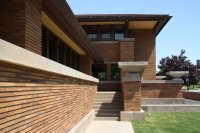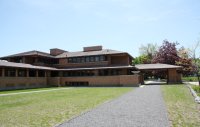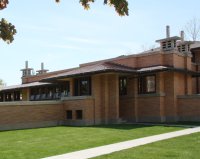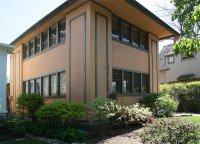
Introduction to the Darwin Martin House complex in Buffalo, New York by Frank Lloyd Wright
The Darwin D. Martin House Complex is considered one of Wright's architectural masterpieces and one of his greatest residential works during his Prairie House period. Its excellence is partly evidenced in the unified composition set in a harmonious landscape, a composition comprised of six buildings which are linked in style and layout. See the plan. These structures include the main house (the Martin House) at about 15,000 square feet; the Barton House, built for Martin's sister Delta and her husband George; the 100 foot pergola, which links the main house with the conservatory; the conservatory which features a replica of the Nike of Samothrace; the carriage house/garage/stable with a chauffeur's apartment on the second level; and the gardener's cottage, built a bit later in 1908. The pergola, conservatory, and carriage house were demolished in 1960, and have been subsequently reconstructed, thus restoring the original unified composition.
The site for this complex of buildings is one and half acres at the corner of Jewett Parkway and Summit Avenue in the Parkside suburb of Buffalo. "It is one of the three large-scale, multi-building complexes among more than sixty houses designed and built to Wright's specifications during the architect's prairie period" (Jack Quinan 13). As Quinan notes the Martin House is 167 feet long, about the equal of five or six typical neighborhood lots.
While the entire complex illustrates Wright's emphasis on the integration of architecture with nature, both the Barton House and the Martin House are representative works in the Prairie architectural style. At this time, the typical Victorian house was vertical with decorative details. In contrast, Wright's Prairie style residences hug the ground. Their horizontality is achieved by low roofs with gentle slopes, cantilevered overhanging eaves, banded windows--creating a long horizontal as well as breaking down the barrier between inside and outside. Wright's plans during this period were often cross-axial (or cruciform) with porches or verandas that extend into the landscape, again making the distinction between outside and inside less dramatic. Often the chimneys are large as a way of anchoring the structure to the ground.
Wright created this complex for Darwin D. Martin, an executive in the Larkin Company. (Wright's Larkin Administration Building (1904-06), a landmark in modern architecture, was demolished in 1950.) Hundred of letters of their correspondence still exist with many of their issues and arguments summarized in Jack Quinan's book (cited below). In spite of Martin's objections, Wright had pretty free rein in the development and budget of this outstanding project. Throughout Martin's life, he was to be a friend and economic support of the creative architect.
According to Jack Quinan (quoting Edgar Tafel, one of the members of the Taliesin Fellowship), the plan of the Martin house was one of Wright's favorites; "he published it frequently (on five occasions during his lifetime), and he pinned it up over his drafting table and made frequent reference to it in discussions with this apprentices" (187). Visitors today may well agree. See the Darwin D. Martin House Complex website for information about tours of this wonderful complex.
Index to the Images of the Darwin Martin House complex in Buffalo, New York
109 images
Works consulted or quoted:
Lesley Neufeld. Frank Lloyd Wright's Martin House Complex. Buffalo: Martin House Restoration Corporation, 2004.
Jack Quinan. Frank Lloyd Wright's Martin House: Architecture as Portraiture. New York: Princeton Architectural Press, 2004.
 Go to the Wright Index.
Go to the Wright Index.
 Click here to return to index of art historical sites.
Click here to return to index of art historical sites.
 Click here to return to index of artists and architects.
Click here to return to index of artists and architects.
 Click here to return to chronological index.
Click here to return to chronological index.
 Click here to see the home page of Bluffton College.
Click here to see the home page of Bluffton College.
© 2009 Mary Ann Sullivan.
I have photographed (on site), scanned, and manipulated all the images on these pages. Please feel free to use them for personal or educational purposes. They are not available for commercial purposes.











 Go to the Wright Index.
Go to the Wright Index. Click here to return to index of art historical sites.
Click here to return to index of art historical sites.
 Click here to return to index of artists and architects.
Click here to return to index of artists and architects.
 Click here to return to chronological index.
Click here to return to chronological index.
 Click here to see the home page of Bluffton College.
Click here to see the home page of Bluffton College.

